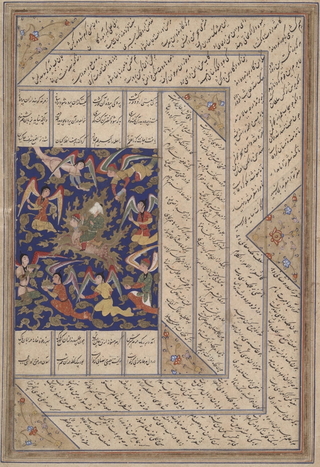The Prophet Muhammad Ascends to the Heavens

The Prophet Muhammad Ascends to the Heavens, Iran, Safavid dynasty, 1501–1722
Accession no. 2001.138.2
Yale University Art Gallery.
The story of the Prophet’s Night Journey (al-Isra) and Ascension (al Mi’raj) has inspired many paintings throughout history. This painting, a Safavid version of the ascension, illustrates the story, as told in Surah Al-Isra in the Quran, in a way that combines symbols of the Shia faith with traditional Islamic symbolism, both abstract and figurative. The Surah Al-Isra describes the night that the Prophet went from Jerusalem to Mecca, aided by the Angel Gabriel. The ascension makes up the main spiritual experience of the night, as the Prophet goes through all 7 heavens until he finally meets Allah.
Beginning by looking at the center of the painting, we see the Prophet riding on Buraq, who accompanies the Prophet during the entirety of this trip and the two are easily identifiable by the golden aura around them. The prophet’s face is veiled and he also wears Haydar’s crown. The addition of this crown, associated with Ali, is what sets it apart from other paintings of the Mi’raj, such as the ones from the Ilkhanid Empire in the late 13th and early 14th centuries, and aids in the Shiification of the Prophet.
As we zoom out, we see the Prophet surrounded by angels in the form of a circle, as they all ascend through the heavens. The circular arrangement of the angels also serves as a Sufi symbol, since the Sufi dances often involve moving your body in cyclical patterns in groups that form a circle. The cyclical movement is said to be a journey toward divine love in Sufism. This is not only a Sufi symbol but an Islamic symbol in general which again shows the painter’s attempts to combine the Sufi beliefs of the Shia-dominated region with traditional Islamic symbolism. Moreover, on the periphery of the painting, the lapis lazuli background is covered with golden whisps. A possible source of these whisps could be the items the angels appear to be carrying. Some of these items are being poured out to add to the aura of the prophet and the similar gold color could symbolize the angels as guides carrying the Prophet with them on this journey.
Sources:
Blair, S., & Bloom, J. Images of Paradise in Islamic Art. Hanover, NH: Hood Museum of Art, 1991.
Gruber, C., & Colby, F. S. The Prophet’s Ascension: Cross-cultural Encounters with the Islamic “Miʻrāj” Tales. Bloomington, IN: Indiana University Press, 2010.
